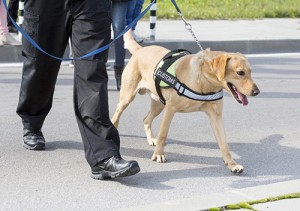 I recently researched “electronic noses,” or the attempt to simulate olfactory senses via electronics and/or chemistry. While there is some wonderful work being done in this area, particularly with polymers at Caltech and electronics at the Monterrey Institute of Technology, I was pulled in the direction of real noses, particularly canine noses. Dogs possess 200–300 million olfactory receptors compared to our five million. It appears that we are just scratching the surface of understanding a dog’s ability to sniff things out. I want to highlight some of the advances in this area.
I recently researched “electronic noses,” or the attempt to simulate olfactory senses via electronics and/or chemistry. While there is some wonderful work being done in this area, particularly with polymers at Caltech and electronics at the Monterrey Institute of Technology, I was pulled in the direction of real noses, particularly canine noses. Dogs possess 200–300 million olfactory receptors compared to our five million. It appears that we are just scratching the surface of understanding a dog’s ability to sniff things out. I want to highlight some of the advances in this area.
Electronic Storage Detection
Instead of using electronics to sniff out substances, dogs are being used to sniff out electronics. In a recent TechRepublic article the authors point out that dogs are used to find hidden electronics, from disk drives all the way down to microSD cards. Forensic researchers isolated compounds that are used in circuit boards and CDs and trained dogs to find them. Digital evidence is increasingly important in criminal investigations so this is a valuable contribution.
Medical Detection Dogs
Animals, particularly dogs, have a keener sense of smell than humans. They can detect small traces of various organic and inorganic substances and can alert to minute variations from norm. Dogs are being trained to detect various biological conditions such as diabetes and allergic reactions. Slight variations in a person’s odor will trigger the dog to react and either seek help or alert the patient. Dogs can also be trained to detect an oncoming seizure or panic attack. Research is being done now to try to train dogs to detect cancers. This is still a work in progress but would be a breakthrough in early intervention.
K9s on Patrol
The most visible group of detection dogs are the K9 units that accompany law enforcement. They can help to apprehend a suspect, but more importantly they can be used in search and rescue situations and are often trained to detect illegal drugs. Drug canines are trained to find particular odors through play practice with a similar scented toy. In essence, they really just want to play.
Other dogs have a very serious duty to detect bombs in police and military work. They are trained to find specific chemicals used in bombs or an improvised explosive device. Unlike drug detecting dogs who actively paw at a potential drug find, the bomb sniffing dogs are trained to sit passively when they detect component chemicals.
Thoughts
With their ultra sensitive noses, it is no wonder that dogs are able to perform critical, possibly lifesaving, work. Can technology ever replicate this? Could such devices be used in areas where dogs would be put in danger, such as search and rescue or toxic environments? I normally write about advances in technology, but wanted to highlight canine heroes that are in many ways better than devices and applications. Tell me about your favorite helpful canine friend.
Kelly Brown is an IT professional and assistant professor of practice for the UO Applied Information Management Master’s Degree Program. He writes about IT and business topics that keep him up at night.

